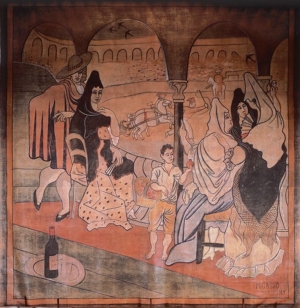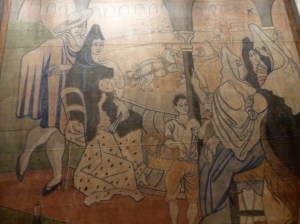|
Displaying items by tag: seagram building
The interior of the Four Seasons restaurant, a vision of Modernist elegance with its French walnut paneling and white marble pool of bubbling water, should not be changed, New York City’s Landmarks Preservation Commission decided on Tuesday.
The decision was a setback to Aby J. Rosen, the owner of the Seagram Building, which is home to the restaurant. Mr. Rosen had proposed what he characterized as minor changes to the interior that was designed by Ludwig Mies van der Rohe and Philip Johnson in 1958.
A masterpiece unfolded on Sunday at the New-York Historical Society, and it wasn’t the Picasso.
In an hourslong operation of practiced precision, “Le Tricorne,” a stage curtain painted by the Spanish master, arrived in its new home, shepherded by a team of art handlers.
It was the end of a tortured ordeal over the fate of the work, which had resided at the Four Seasons restaurant in the Seagram Building only to be pushed out in a dispute between the landlord and the New York Landmarks Conservancy.
The New-York Historical Society is to unveil Pablo Picasso's iconic painted theater curtain, commissioned for Serge Diaghilev's Ballets Russes, Le Tricorne, in 1919. The masterpiece is the largest work by the Spanish born artist in America. It was donated by the Landmarks Conservancy to the New-York Historical Society and after considerable conservation will be on view to the public, later this spring. The Le Tricorne curtain was installed as a tapestry for 55 years at the Four Seasons Restaurant in the Mies van der Rohe designed, modernist, Seagram Building, in New York City.
On Sunday, October 5, three monumental sculptures by Alexander Calder took up residence at the Seagram Building on Park Avenue in New York. The installation is part of a collaboration between Pace Gallery, a leading contemporary art gallery based in New York, and the Alexander Calder Foundation. The presentation will coincide with Storm King Art Center’s annual gala on October 8, which will be held in the Seagram Building’s famed Four Seasons restaurant. The gala will honor the Calder Foundation and its president, Alexander S.C. Rower, the artist’s grandson. Located sixty miles north of New York City, Storm King’s sprawling outdoor sculpture park features a number of works by Calder.
Pace Gallery, which represents Calder’s estate, has installed the three sculptures in front of the Seagram Building.
In the dead of night, a 95-year-old Picasso went under the knife.
“Anything goes wrong, just stop what you’re doing,” the lead technician, Tom Zoufaly, commanded. “I don’t want to hear any screaming, yelling.”
The scene of the operation was the Four Seasons restaurant on Park Avenue, home since 1959 to “Le Tricorne,” a 19-by-20-foot stage curtain painted by Pablo Picasso. The curtain had been caught in a dispute between the New York Landmarks Conservancy, which owns the piece, and Aby J. Rosen, the owner of the landmark Seagram Building, where it resided. Mr. Rosen wanted it taken away.

After an ongoing battle, it has been decided that Pablo Picasso’s “Le Tricorne,” a centerpiece of New York’s famed Four Seasons Restaurant, will be removed from the establishment. The 19-by-20-foot stage curtain, which has resided in the Seagram Building on Park Avenue since 1959, will be relocated to the New-York Historical Society.
Back in February, officials announced that the tapestry would need to be removed so that the wall behind it could be repaired. However, many experts feared that the delicate masterpiece could be severely damaged in the removal process. The tapestry’s owner, the New York Landmarks Conservancy, entered into a dispute with the Seagram Building's owner, Aby Rosen, a prominent figure in real estate and art circles. After heading to court and spending weeks negotiating the fate of “Le Tricorne,” Rosen and Peg Breen, president of the conservancy, agreed that the Historical Society would be a deserving home for the tapestry. The piece, which is the largest work by Picasso in the United States, will be the focal point of the society’s second-floor gallery.

Justice Matthew F. Cooper ruled in a New York State Supreme Court that RFR Holding, the real estate company that owns the Seagram Building on Park Avenue, cannot remove Pablo Picasso’s ‘Le Tricorne’ from a wall of the Four Seasons Restaurant until the court issues a final ruling on the future of the art. The 19-foot-tall tapestry has hung in the Four Seasons, which is located inside the Seagram Building, for over 55 years.
The work was to be removed so that the wall behind the tapestry could be repaired, but the New York Landmarks Conservancy, which owns the tapestry, feared that the work would be damaged in the process and filed an injunction to halt the undertaking. During the court hearing, Justice Cooper said, “We’re not talking about wallpaper. We’re not talking about a poster. We’re talking about an irreplaceable Picasso...It’s part of New York’s social and cultural fabric.”
Peg Breen, the president of the Landmarks Conservancy, believed that once the tapestry was removed from the Four Seasons, Aby Rosen, an RFR founder, would replace it with a more contemporary work of art. Per Justice Cooper’s ruling, the tapestry cannot be removed from its current location without the Conservancy’s consent.
The Four Seasons Restaurant on Park Avenue in New York City will remove Pablo Picasso’s ‘Le Tricorne’ from its lobby. The 19-foot-tall tapestry has hung in the Seagram Building, home to the Four Seasons, for over 55 years. The work will be removed so that the wall behind the tapestry can be repaired. However, many experts fear that the masterpiece could be severely damaged in the removal process.
While the Seagram Building is owned by RFR Holding, the Picasso tapestry is owned by the New York Landmarks Conservancy. Peg Breen, the president of the Conservancy, believes that once the painting is removed, RFR Holding’s executive, Aby Rosen, will replace it with a more contemporary work of art. The Museum of Modern Art has offered to keep the tapestry in storage if it does not return to the Four Seasons.
‘Le Tricorne’ is slated to be removed on February 9, 2014.

Thirty-five out of forty-four senior art students were left without their sketchbooks, canvases, brushes, books, and completed works after a fire broke out at Pratt Institute in New York City on February 15, 2013. The fire, which ignited in Pratt’s historic Main Building due to faulty electrical wiring, also destroyed much of the structure’s roof and the studios that painting students are given in their final year.
In an effort to ease the students’ crushing loss, art dealer Larry Gagosian has partnered with Pratt to present a special drawing and painting exhibition. Gagosian was especially moved by Pratt’s fire as he almost lost a sizable chunk of his own collection after a fire broke out at his home in the Hamptons in 2011.
Flameproof will feature 100 works by Pratt’s 44 senior drawing and painting students and will be curated by Eugenie Tsai, the John and Barbara Vogelstein Curator of Contemporary Art at the Brooklyn Museum. The exhibition is focused on the students’ collective experience at Pratt and was largely facilitated by the Pratt recovery effort, which provided students with donated supplies and gift cards from the school’s administration and local art stores.
Flameproof will be held at the Seagram Building on Park Avenue from May 9-14, 2013.
One of Mark Rothko’s Seagram murals was defaced on Sunday at the Tate Modern. Black on Maroon (1958), which is valued at tens of millions of dollars, was a gift to the museum by the Modernist artist.
The defacer, Vladimir Umanets, scrawled “Vladimir Umanets, A Potential Piece of Yellowism.” in black ink in the lower right-hand corner of the piece. Umanets claims that it was not an act of vandalism as he was adding something new to the piece and acting in line with the bizarre art movement, Yellowism.
One of modern art’s most important figures, Rothko painted Black on Maroon as part of a series originally commissioned by the Four Season in New York City which was located in the Seagram Building, a renowned modernist skyscraper. Rothko decided not to give the paintings to the Four Seasons upon completion because he did not want them to become a backdrop for wealthy diners. In 1965 he donated some of the works to the Tate and nine were delivered in 1970 on the day the artist died.
|
|
|
|
|